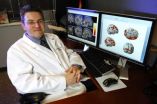(Press-News.org) Rice University senior engineering students are using the sun to power an autoclave that sterilizes medical instruments and help solve a long-standing health issue for developing countries.
The student's used Capteur Soleil, a device created decades ago by French inventor Jean Boubour to capture the energy of the sun in places where electricity -- or fuel of any kind -- is hard to get. In attaching an insulated box containing the autoclave, the students transform the device into a potential lifesaver.
The Capteur Soleil, which sits outside Rice's Oshman Engineering Design Kitchen, looks something like an ultramodern lawn swing. Its spine is a steel A-frame, and a bed of curved mirrors beneath the frame produces steam by focusing sunlight along a steel tube at the frame's apex. Rather than pump steam directly into the autoclave, the Rice team's big idea was to use the steam to heat a custom-designed conductive hotplate.
"It basically becomes a stovetop, and you can heat anything you need to," said Sam Major, a member of the team with seniors Daniel Rist, David Luker and William Dunk, all mechanical engineering students. "As long as the autoclave reaches 121 Celsius for 30 minutes (the standard set by the Centers for Disease Control and Prevention), everything should be sterile, and we've found we're able to do that pretty easily."
He said one person could easily adjust the Capteur Soleil by ratcheting up the back leg to align the mirrors with the sun. Within half an hour of receiving strong sunlight, the Capteur Soleil will begin to produce steam, which will in turn heat the patterned hotplate and then the standard-issue, FDA-approved autoclave. With good midday sun, Major said, it takes 40 minutes to an hour to begin significant heating of the autoclave.
The autoclave, which looks like a tricked-out pressure cooker, has a steamer basket inside. "We put about an inch of water inside, followed by the basket with the tools and syringes," Major said. "We've used some biological spores from a test kit, steamed them, and then incubated them for 24 hours and they came back negative for biological growth. That means we killed whatever was in there."
The autoclave, tucked inside a plywood frame, is wrapped in silicon-based Thermablok insulation, which has the highest R-value of any known material and is a spinoff from NASA research into thermal protection for the space shuttle. "This thin layer does most of the work," Major said. "We used standard pink insulation around the inside just to make the box stronger."
"This is really the latest iteration of a much larger project," said Doug Schuler, the team's faculty adviser and an associate professor of business and public policy at Rice's Jones Graduate School of Business. "We already have a version of the Capteur Soleil being used in Haiti for cooking, but we felt it could do more."
###
A video of students discussing and demonstrating the autoclave is available at
http://www.youtube.com/watch?v=fPuQG8pCeyM
Download a high-resolution photo of the team and device at
http://www.media.rice.edu/images/media/NEWSRELS/0428_AUTOCLAVE.JPG
CAPTION:
For their senior capstone design project, the members of Team Sterilize refitted the Capteur Soleil at Rice's Oshman Engineering Design Kitchen to sterilize medical instruments and supplies with the power of the sun. From left, David Luker, William Dunk, professor and team adviser Doug Schuler, Daniel Rist and Sam Major.
(Credit Jeff Fitlow/Rice University)
Located on a 285-acre forested campus in Houston, Texas, Rice University is consistently ranked among the nation's top 20 universities by U.S. News & World Report. Rice has highly respected schools of Architecture, Business, Continuing Studies, Engineering, Humanities, Music, Natural Sciences and Social Sciences and is known for its "unconventional wisdom." With 3,485 undergraduates and 2,275 graduate students, Rice's undergraduate student-to-faculty ratio is less than 6-to-1. Its residential college system builds close-knit communities and lifelong friendships, just one reason why Rice has been ranked No. 1 for best quality of life multiple times by the Princeton Review and No. 4 for "best value" among private universities by Kiplinger's Personal Finance. To read "What they're saying about Rice," go to http://futureowls.rice.edu/images/futureowls/Rice_Brag_Sheet.pdf.
END
URBANA – A Vietnam veteran who conducted early-morning mine sweeps on that country's roads, University of Illinois nutrition professor John Erdman knows the damage that a traumatic brain injury (TBI) can cause. That's why he was happy to chair a committee that gave the Department of Defense recommendations that will improve the odds of recovery for persons wounded by roadside bombs.
"Within the first 24 hours after head trauma, patients need to receive at least 50 percent of their normal caloric intake, including a higher-than-normal amount of protein, to reduce inflammation ...
At the request of customers, software development firm Halfpricesoft has launched the new edition of check printing software to make it easier to print Quickbooks compatible checks.
"We have a strong following of small business customers who love our other time-saving and money-saving software titles." said Dr. Ge, founder of Louisville, Ky.-based Halfpricesoft, "With ezCheckPrinting, check writing and printing software, user never need to re-order the expensive pre-printed checks. And new blank check printing feature makes it even easier to print pre-printed ...
HOUSTON (May 2, 2011) – Colorectal cancer screening rates increased for Medicare beneficiaries when coverage was expanded to average-risk individuals, but racial disparities still exist, according to researchers at The University of Texas Health Science Center at Houston (UTHealth).
"Despite the expansion of Medicare coverage for colorectal cancer screening, disparities persisted among the ethnic groups we examined," said Arica White, Ph.D., M.P.H., former doctoral student at The University of Texas School of Public Health, part of UTHealth. In 1998, Medicare began covering ...
NEW YORK – May 3, 2011 –A study by Columbia Business School Professors Amit Khandelwal, a Jerome A. Chazen Institute of International Business senior scholar and assistant professor, Finance and Economics, and Shang-Jin Wei, director, Jerome A. Chazen Institute of International Business, and N.T. Wang Professor of Chinese Business and Economy, Finance and Economics, alongside JaeBin Ahn, a Ph.D. candidate in economics at Columbia University, provides the first empirical evidence that quantifies the role of intermediary firms in developing and expanding international trade ...
WASHINGTON, DC (May 3, 2011) – A coalition of 30 leading global health organizations that work on vaccines, drugs, and other tools and technologies that save lives today released a list of recommendations for US policymakers and regulators, calling for acceleration of scientific innovations and streamlining the approval of safe and affordable inventions in order to save more lives around the world.
The Global Health Technologies Coalition (GHTC), a group funded by the Bill & Melinda Gates Foundation and designed to give a greater voice for those advancing technologies ...
PHILADELPHIA — Biophysicists at the University of Pennsylvania have helped develop a new technique for studying how proteins respond to physical stress and have applied it to better understand the stability-granting structures in normal and mutated red blood cells.
The research was conducted by Dennis Discher and Christine Krieger in the Molecular and Cell Biophysics Lab in Penn's School of Engineering and Applied Science, along with researchers from the New York Blood Center and the Wistar Institute.
Discher's research was published online in the journal Proceedings ...
HOUSTON -- (May 3, 2011) -- A Rice University-led team of physicists this week offered up one of the first theoretical explanations of how two dissimilar types of high-temperature superconductors behave in similar ways.
The research appears online this week in the journal Physical Review Letters. It describes how the magnetic properties of electrons in two dissimilar families of iron-based materials called "pnictides" (pronounced: NICK-tides) could give rise to superconductivity. One of the parent families of pnictides is a metal and was discovered in 2008; the other ...
CAMBRIDGE, Mass. -- MIT chemical engineers have designed a new type of drug-delivery nanoparticle that exploits a trait shared by almost all tumors: They are more acidic than healthy tissues.
Such particles could target nearly any type of tumor, and can be designed to carry virtually any type of drug, says Paula Hammond, a member of the David H. Koch Institute for Integrative Cancer Research at MIT and senior author of a paper describing the particles in the journal ACS Nano.
Like most other drug-delivering nanoparticles, the new MIT particles are cloaked in a polymer ...
Ecstasy – the illegal "rave" drug that produces feelings of euphoria and emotional warmth – has been in the news recently as a potential therapeutic. Clinical trials are testing Ecstasy in the treatment of post-traumatic stress disorder.
But headlines like one in Time magazine's health section in February – "Ecstasy as therapy: have some of its negative effects been overblown?" – concern Ronald Cowan, M.D., Ph.D., associate professor of Psychiatry.
His team reports in the May issue of Neuropsychopharmacology that recreational Ecstasy use is associated with a chronic ...
Boston, MA – A common component in webcams may help drug makers and prescribers address a common side-effect of drugs called cardiotoxicity, an unhealthy change in the way the heart beats. Researchers at Brigham and Women's Hospital (BWH) have used the basic webcam technology to create a tool to look at the effects of medications in real time on heart cells, called cardiomyocytes. These findings were published in the journal, Lab on a Chip on April 11, 2011.
Researchers developed a cost-effective, portable cell-based biosensor for real time cardiotoxicity detection using ...

